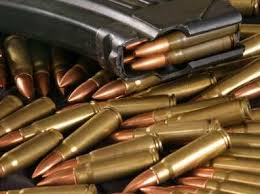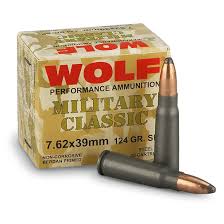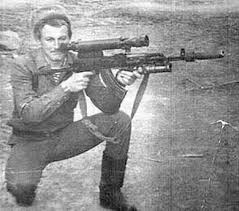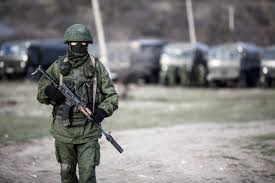A primer on 7.62 AK ammo
 Far and away one of the least expensive rifle calibers out there to train with is the 7.62×39. It’s not a shocker that many to stock up in bulk and its a great round to do so. The bullet works- sure, there’s others that increase range, accuracy and terminal effect, but essentially it does what it was designed to do within the parameters of which it was designed: the intermediate ~300M range.
Far and away one of the least expensive rifle calibers out there to train with is the 7.62×39. It’s not a shocker that many to stock up in bulk and its a great round to do so. The bullet works- sure, there’s others that increase range, accuracy and terminal effect, but essentially it does what it was designed to do within the parameters of which it was designed: the intermediate ~300M range.
That said, it round needs no introduction to most of the readership. Veterans know it well, hunters especially in the Southern US know it as the poor man’s 30-30, and range rats know it as the fun caliber to shoot on the cheap. Like the 30-30, it carries a similar energy and trajectory, punches through brush fairly easily without a significant impact on bullet path, and reliably does what’s needed. Many Survivalists have stocked away lifetime supplies of the round just based on it’s price point of both the round and the weapons that fire it. While its easy to ride down to the local gun shop or ammo website and pick up a few hundred rounds, not all of the ammo is the same- and while there’s not a big difference in cost, there can be quite a variance in the projectiles themselves.
Just like with 5.56, 7.62×51, etc, there’s a plethora of different rounds, some being better than others. Many, many folks I’ve run into are guilty of lumping it together in to one sole category as if there’s no difference. Concerning accuracy there’s not a wide variety between the stuff coming from Russia, but terminal effect-wise, the differences become more clear. If you’re buying bulk there’s a couple of specific rounds to look for, aside from simply what’s the cheapest. Of the loadings, there’s three general types; Full Metal Jacket, Hollow Point, and Soft Point. Among these, as anyone familiar with terminal ballistics will attest, the SP round is generally the most desirable. Full metal jackets are great for playing on the range, but not my first choice for desirable ammo. Yugoslavian surplus ammo is a minor exception, but the stuff is getting hard to come by and is corrosive, so I avoid it. Hollow points are the most confusing category to many, due to the wide variety of ammunition imported but not always clearly indicated. They range from simply being an AK version of Open Tip Match (a tiny hole in the tip with little to no expansion properties) to HPs with pre-fail cuts inside the round itself. 
The common bullets weights for 7.62×39 range from 122 to 125gr, with a 154gr hunter’s load on the market as well made by Tula. I don’t recommend bulking up on the 154 if you’re running an AK, as the additional weight may cause premature wear on the recoil spring, bolt carrier, and rear trunion. In purchasing bulk general purpose ammo, 125gr SP is most desirable of what’s commonly available sight unseen, with it being the best medium between mass, speed, effect, and cost effectiveness. It may not be a premium hunting round, but the chances of it yawing or expanding is higher than with simple FMJ.
 The next most sought after round is not as easy to come by, and a great amount of confusion surrounds it’s source. It’s known as 8m3, sometimes referred to as the “Sapsan” round after the original imported brand name. SG Ammo gets it in regular supply. 8m3 is a 124gr HP with pre-fail cuts in the jacket, allowing greater fragmentation on impact. 8m3 has an intriguing story of how it came about, not unlike our load development changes in 5.56 and 7.62×51 coming from experiences in Afghanistan and Iraq.
The next most sought after round is not as easy to come by, and a great amount of confusion surrounds it’s source. It’s known as 8m3, sometimes referred to as the “Sapsan” round after the original imported brand name. SG Ammo gets it in regular supply. 8m3 is a 124gr HP with pre-fail cuts in the jacket, allowing greater fragmentation on impact. 8m3 has an intriguing story of how it came about, not unlike our load development changes in 5.56 and 7.62×51 coming from experiences in Afghanistan and Iraq.
The 5.45 experienced shortcomings with Russian troops in Chechnya, ricocheting off of and fragmenting when hitting intermediate barriers, as well as having limited close range effectiveness. The extended engagement ranges of Afghanistan that favored the newer, faster 5.45 had given to close range fights in urban and dense forest.  Although superseded as the primary service caliber by the 5.45x39mm AK-74 in Afghanistan, the AKM continued to be used in a limited, specialized role in conjunction with the PBS-1 suppressor and rudimentary (although high tech in it’s day) starlight scope, seen at right. The 7.62 round, being a great deal slower, was still quite effective within medium ranges and lost less energy from the effects of the suppressor.
Although superseded as the primary service caliber by the 5.45x39mm AK-74 in Afghanistan, the AKM continued to be used in a limited, specialized role in conjunction with the PBS-1 suppressor and rudimentary (although high tech in it’s day) starlight scope, seen at right. The 7.62 round, being a great deal slower, was still quite effective within medium ranges and lost less energy from the effects of the suppressor.
This limited role platform was re-recognized in the next decade during the Chechen crisis, and the 7.62 was employed yet again due to it’s favorable attributes of energy retention at close range even when suppressed and superior intermediate barrier penetration.  Other weapons have since been purpose built to fill this role (such as the 9x39mm VSS) but due to the sheer numbers of AKMs and 7.62 ammo in the inventory, it still sees widespread use even as recent as the ‘polite green men’ invasion of Crimea.
Other weapons have since been purpose built to fill this role (such as the 9x39mm VSS) but due to the sheer numbers of AKMs and 7.62 ammo in the inventory, it still sees widespread use even as recent as the ‘polite green men’ invasion of Crimea.
Recognizing the need to maximize the 7.62, Ulyanovsk ammunition plant (makers of Wolf Military Classic and sometimes Wolf black box) developed a new anti personnel round with pre-fail cuts to guarantee expansion on impact.  The new 8m3 round was issued to domestic security units and was sold commercially. Fortunately it’s still available stateside for those careful enough to look.
The new 8m3 round was issued to domestic security units and was sold commercially. Fortunately it’s still available stateside for those careful enough to look.
8m3 is a 124gr bullet, most commonly found in Wolf Military Classic, but also occasionally in Tulammo, which used to be known as Wolf, loaded at Tula arsenal. Not all HPs are 8m3…only the 124gr, and not all of those either. One way to make sure you have 8m3 is to take a finishing nail or pin and rub the inside of the cavity, checking the pre-fail notches. The ammo works well, and is far superior in terminal performance to FMJ.
 The round’s effect, seen in this gel test, is a good demonstration of it’s wounding capacity just after it enters and creating a large channel. It’s great ammunition and should be sought after if you’re looking to run the AK.
The round’s effect, seen in this gel test, is a good demonstration of it’s wounding capacity just after it enters and creating a large channel. It’s great ammunition and should be sought after if you’re looking to run the AK.
Conclusions
The Soft Point and 8m3 HP are the two most economical yet effective rounds on the market for the AKM. Caliber and platform arguments aside (which is a stupid, stupid waste of time normally argued by folks who’ve never fired a shot in anger) you as the shooter should be looking at every way possible to maximize the effectiveness of your equipment. Increasing the lethality of your rounds is a great step in the right direction. This article is not meant to ignite a caliber or weapon shouting match, but rather inform based on the best of the options out there for the AK platform or the AR or even one of those neat PTR-31s. You may not have enough ammo for what’s coming down the pipe, but you can at least know which rounds to acquire till that day arrives.
Share This Story, Choose Your Platform!
17 Comments
Comments are closed.






































[…] There are differences. […]
5
Great article! I don’t have an AK anymore but I did keep a case of the Military Classic 124gn. I have simplified my gear and decided on Glock 9mm and AR15s. Both very reliable and effective. Also kept a couple of Colt safe queens for the grandchildren.
I own more then ten, but less then 20 AKs. I’ve been purchasing them since the late 70s, early 80s. Why, they were cheap, like 100.00 130.00 apiece. Even back then I foresaw the potential need for a competent mid distance rifle that was simplistic, to run and clean. And ammo, no idea how much I’ve got.
I do know I’ve shot up pretty much 9″ cases of the wolf, it worked fine, nothing remarkable to share. That ammo was purchased back when 100 or 1400 round cases was 100.00 ish dollars. Frankly I’m not a big fan, who cares, these are tools, fairly accurate, but rock solid. I’ve had an at umder the back seat of all my trucks for 25 years plus. And 10 thirty rounders. I shoot a mag a year out of this one.
It’s a crusty old MAK 90, with a folding stock. I’ve cleaned French fries out of the action, all kinds of shit, my kids dropped behind the seat. A shoe string and a dab of engine oil from my engine dip stick, is all I’ve ever done to clean this gun. It’s combat accurate to 3/4oo, they all are.
Their’s a reason I keep an ak behind the seat. No m4 could ever take the abuse these AKs get. Rather lack of love, oiling cleaning etc etc.
Back to,ammo. I can’t think,of a time I’ve ever had a squid out of an ak, or purchased ammo. I’m not,particular what ammo I’m running, but I have many many yugo 1440 round cases in wooden cases, that seems to run especially well. I’m going to start a uniform ammo purchase again. Going to bite the bullet and stock up on the 69/77 grain 223, and I need to restock my 7.62 with the 147 grain for the FNs M14s and the bm59s and bm62s. and the 3006 140? G for the M1 and 03a3s.
I’m amazed at just how expensive the AKs have gotten. Their are many other rifles Ill purchase for the money before I’ll purchase any more AKs.
Perhaps the finest ak varient I own is the Valmets, if you can source one, do so, these rifles are quality built, the Galils were built using this AKs machined receiver. Bitchen rifles. Hard to find anymore. I don’t worry I know where several are!
Great article.
DW
The days of the $300 WASR are long gone, but, ammo-wise, it still ain’t bad. The WASR and the other Romanian imports (M10 and Draco) are much better today than they were a decade ago and in my opinion worth the $6-700 they cost. They’re complete weapons as imported, not just surplus parts kits cobbled together by Centry’s lowest bidder. They are very good rifles, and the one pictured in the title post is an AMD-mod WASR 10. Now the market for surplus mags is a different story and worthy of a post all its own. Those Valmets- rare as hen’s teeth these days. Excellent weapons from Finland and the Lapua AK ammo made there is excellent.
Great post! Another gem from one of my favorite bloggers. Now you’re making me want to run an AK, just for fun!
Get one. They’re a lot of fun, they’re cheap to bang away with in a good training session, and that 8m3 from the embedded link is excellent close to mid range ammo.
A note of caution on Tula – I had a round hang in the barrel of my Izmash AK – only the purest of good luck I didn’t fire another round afterward. I had it happen again but in a 9mm handgun; the problem may have been the powder, I don’t know. What I DO know is that I’ll never run Tula ammo again.
Golden Tiger seems to be excellent quality, lacquer sealed primer and bullet, yet still inexpensive. It’s also a boat tail round and it does seem to throw cans and such way up in the air whereas the usual ball ammo does not.
GT is great ammo. Uly (Wolf MC) ain’t bad. That 8m3 in the embedded link is the best on the market.
Whatever the caliber, I always stock up on Steel-core ammo whenever it’s available. I got a good stockpile of both 7.62x39mm & 5.45x39mm before import was banned and a stockpile of 8mm Mauser steel-core & a kinetic bullet puller to work up loads for 8mm Rem. Mag.
Most of the AK ammo seems to be steel cased. There are some brass cased offerings. Would there be any reason why someone might want to go with brass over steel for the AKM ? I believe that the steel ammo is berdan primed where the brass is boxer primed. I Have no experience reloading with berdan primers (not sure if you can..) then again if we are to stock up massively on cheap but effective, berdan primed, steel cased 7.62x39mm then reloading would not be as much of a concern in the general strategy for this particular caliber ? Great article !!
Brass case 7.62×39 is just more expensive, except for the Yugo stuff. Steel case is popular because its cheap- and since the AK launches spent casings into the next zip code anyway, I’m not too worried about reloading. The guys with bolt guns in it probably are though.
The main reason I can think of is bullet selection.
Russian steelcase 7.62x39mm ammo also almost universally uses steel jacketed bullets, and, due to thick jackets, inconsistent velocities, and mediocre QC in manufacture, expanding bullets usually don’t. Ulyanovsk 8M3 hollowpoints and Tula 154gr softnoses are the best of a mediocre lot, head and shoulders above the rest.
Golden Tiger FMJ supposedly incorporates a large air space in the front of the bullet under the tip to force its center of gravity rearward and make it more apt to yaw in soft tissue, which it seems to do pretty consistently, at least in ballistic gelatin and other artificial media. Surplus Yugo M67 brass-cased FMJ behaves similarly, but that ammo is Berdan-primed, corrosive, and, these days more expensive than new production Russian steel-case.
Seller & Bellot (Czech) and Igman/Prvi Partizan (Yugo) brass cased 7.62x39mm ammo is available with copper jacketed softpoints that actually expand pretty reliably. Be prepared to pay 45-50 cents a round for this ammo in bulk, though, which is about double what Russian steelcase runs.
[…] Just run good ammo. […]
you should test any foreign soft point you are going to us before buying much . There are videos of them being fired into ballistic gel . they don’t expand because the jackets are too thick . golden bear 124 gr didn’t https://www.youtube.com/watch?v=H6RVuISLJ3o , herters 154 gr didn’t https://www.youtube.com/watch?v=BOHrY9KiR2A Tula 154 gr DID https://www.youtube.com/watch?v=-UWA2-ZvXFI
4.5
4